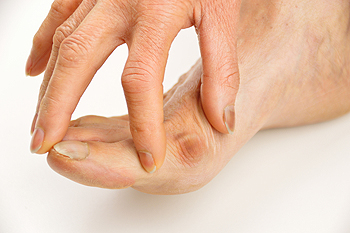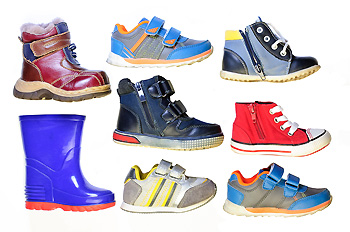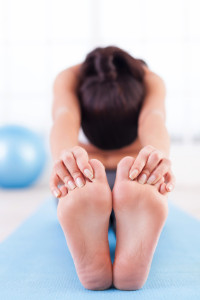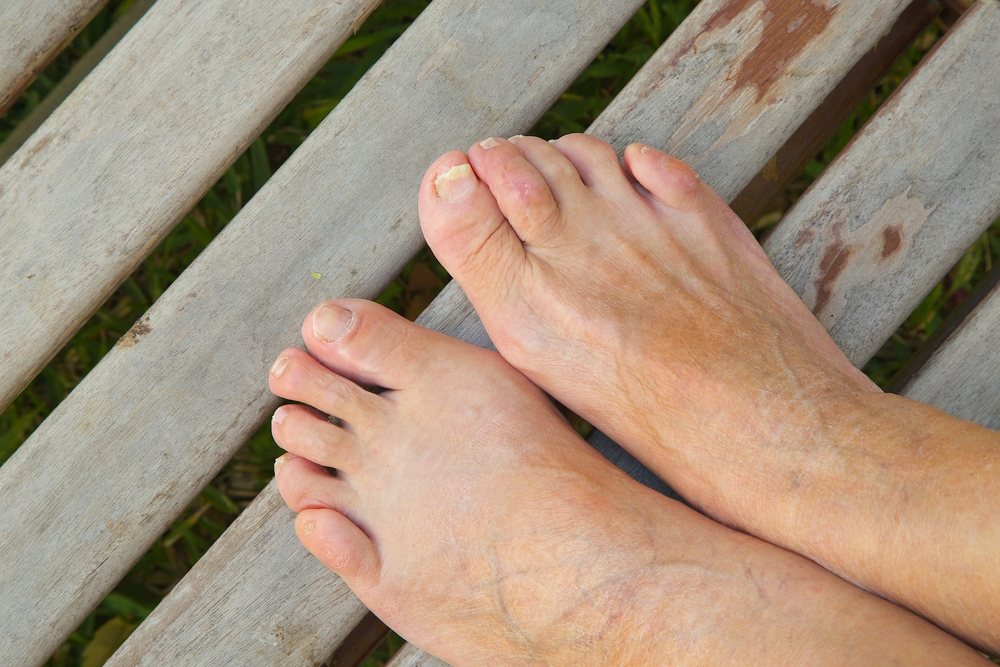 Bunions that develop in young children are referred to as juvenile hallux valgus. They may exist as a result of genetic traits, or from wearing shoes that do not have adequate room for the toes to move freely in. Noticeable signs that your child may have a bunion can include a bony protrusion that forms on the side of the big toe, and red and swollen appearance. A proper diagnosis can consist of having an X-ray taken, as this may help to determine how severe the bunion is. When the bunion is identified at an early stage, it may be effective to use non-surgical techniques to obtain mild relief. These can include wearing shoes that have a wide toe area, or using custom-made insoles that may help to alleviate pressure. If your child has a bunion, it is strongly suggested that you seek the counsel of a podiatrist who can properly treat this condition.
Bunions that develop in young children are referred to as juvenile hallux valgus. They may exist as a result of genetic traits, or from wearing shoes that do not have adequate room for the toes to move freely in. Noticeable signs that your child may have a bunion can include a bony protrusion that forms on the side of the big toe, and red and swollen appearance. A proper diagnosis can consist of having an X-ray taken, as this may help to determine how severe the bunion is. When the bunion is identified at an early stage, it may be effective to use non-surgical techniques to obtain mild relief. These can include wearing shoes that have a wide toe area, or using custom-made insoles that may help to alleviate pressure. If your child has a bunion, it is strongly suggested that you seek the counsel of a podiatrist who can properly treat this condition.
If you are suffering from bunion pain, contact Brent Harwood, DPM of Southeast Podiatry. Our doctor can provide the care you need to keep you pain-free and on your feet.
What Is a Bunion?
Bunions are painful bony bumps that usually develop on the inside of the foot at the joint of the big toe. As the deformity increases over time, it may become painful to walk and wear shoes. Women are more likely to exacerbate existing bunions since they often wear tight, narrow shoes that shift their toes together. Bunion pain can be relieved by wearing wider shoes with enough room for the toes.
Causes
Symptoms
In order to diagnose your bunion, your podiatrist may ask about your medical history, symptoms, and general health. Your doctor might also order an x-ray to take a closer look at your feet. Nonsurgical treatment options include orthotics, padding, icing, changes in footwear, and medication. If nonsurgical treatments don’t alleviate your bunion pain, surgery may be necessary.
If you have any questions, please feel free to contact one of our offices located in Fairhope, Brewton, and Atmore, AL . We offer the newest diagnostic and treatment technologies for all your foot care needs.
 An effective type of therapy that many babies and children respond positively to is reflexology. Parents have found it can help the child to feel better, and may reduce feelings of irritability. The results are often experienced immediately, and this can happen due to undeveloped arches and soft bones in the feet. This type of therapy can be used as a natural healing tool for existing illnesses, in addition to maintaining optimum health. There are several techniques that are used on babies and children of different ages, and it is suggested that you schedule a consultation with a podiatrist who can inform you of the benefits of reflexology for your children.
An effective type of therapy that many babies and children respond positively to is reflexology. Parents have found it can help the child to feel better, and may reduce feelings of irritability. The results are often experienced immediately, and this can happen due to undeveloped arches and soft bones in the feet. This type of therapy can be used as a natural healing tool for existing illnesses, in addition to maintaining optimum health. There are several techniques that are used on babies and children of different ages, and it is suggested that you schedule a consultation with a podiatrist who can inform you of the benefits of reflexology for your children.
The health of a child’s feet is vital to their overall well-being. If you have any questions regarding foot health, contact Brent Harwood, DPM of Southeast Podiatry. Our doctor can provide the care you need to keep you pain-free and on your feet.
Tips for Keeping Children's Feet Healthy
If you have any questions, please feel free to contact one of our offices located in Fairhope, Brewton, and Atmore, AL . We offer the newest diagnostic and treatment technologies for all your foot care needs.
Read more about How to Care for Your Child's Feet If you are experiencing pain, weakness, soreness, or a lack of flexibility in your feet or ankles, you may want to start practicing certain stretches. Stretching the feet and ankles can help to benefit the overall health of your lower extremities. One simple stretch you can practice allows you to sit comfortably in a chair. Once seated, begin by raising your toes, point them, and then curl them under. You’ll want to repeat this motion 10 times to help strengthen your mobility and build flexibility. Another stretch you can perform is called the marble pick-up, and is more focused on strength. Sit with your back straight and your feet in front of you. Place marbles in front of you and begin to pick them up with your toes. Start by using the toes of the right foot, then switch to your left. For more suggestions on what stretches you can practice to help the overall health of your feet, please speak with a podiatrist.
If you are experiencing pain, weakness, soreness, or a lack of flexibility in your feet or ankles, you may want to start practicing certain stretches. Stretching the feet and ankles can help to benefit the overall health of your lower extremities. One simple stretch you can practice allows you to sit comfortably in a chair. Once seated, begin by raising your toes, point them, and then curl them under. You’ll want to repeat this motion 10 times to help strengthen your mobility and build flexibility. Another stretch you can perform is called the marble pick-up, and is more focused on strength. Sit with your back straight and your feet in front of you. Place marbles in front of you and begin to pick them up with your toes. Start by using the toes of the right foot, then switch to your left. For more suggestions on what stretches you can practice to help the overall health of your feet, please speak with a podiatrist.
Why Stretching Is Important for Your Feet
Stretching the feet is a great way to prevent injuries. If you have any concerns with your feet consult with Brent Harwood, DPM from Southeast Podiatry. Our doctor will assess your condition and provide you with quality foot and ankle treatment.
Stretching the Feet
Stretching the muscles in the foot is an important part in any physical activity. Feet that are tight can lead to less flexibility and make you more prone to injury. One of the most common forms of foot pain, plantar fasciitis, can be stretched out to help ease the pain. Stretching can not only ease pain from plantar fasciitis but also prevent it as well. However, it is important to see a podiatrist first to determine if stretching is right for you. Podiatrists can also recommend other ways to stretch your feet. Once you know whether stretching is right for you, here are some excellent stretches you can do.
It is best to go easy when first stretching your foot and work your way up. If your foot starts hurting, stop exercising to ice and rest the foot. It is advised that you then see a podiatrist for help.
If you have any questions, please feel free to contact one of our offices located in Fairhope, Brewton, and Atmore, AL . We offer the newest diagnostic and treatment technologies for all your foot care needs.
 A hammertoe, as its name suggests, is a condition that affects the joints of the toe, causing it to bend in a downward shape, resembling a hammer. To help improve the toe’s flexibility, lessen the pain caused by the hammertoe, and to straighten the affected toe, surgery may be a good option for you. Surgery for a hammertoe will typically be suggested by a professional after conservative treatments, such as splints or orthotics, have failed to improve the condition. To help prepare for surgery, your podiatrist may suggest seeing a physical therapist, keeping weight off of your toe, and practicing certain exercises to help improve your overall balance in order to prepare you for moving around post-surgery. To help decide if surgery is the best treatment option for you, please consult with a podiatrist.
A hammertoe, as its name suggests, is a condition that affects the joints of the toe, causing it to bend in a downward shape, resembling a hammer. To help improve the toe’s flexibility, lessen the pain caused by the hammertoe, and to straighten the affected toe, surgery may be a good option for you. Surgery for a hammertoe will typically be suggested by a professional after conservative treatments, such as splints or orthotics, have failed to improve the condition. To help prepare for surgery, your podiatrist may suggest seeing a physical therapist, keeping weight off of your toe, and practicing certain exercises to help improve your overall balance in order to prepare you for moving around post-surgery. To help decide if surgery is the best treatment option for you, please consult with a podiatrist.
Hammertoe
Hammertoes can be a painful condition to live with. For more information, contact Brent Harwood, DPM from Southeast Podiatry. Our doctor will answer any of your foot- and -related questions.
Hammertoe is a foot deformity that affects the joints of the second, third, fourth, or fifth toes of your feet. It is a painful foot condition in which these toes curl and arch up, which can often lead to pain when wearing footwear.
Symptoms
Causes
Genetics – People who are genetically predisposed to hammertoe are often more susceptible
Arthritis – Because arthritis affects the joints in your toes, further deformities stemming from arthritis can occur
Trauma – Direct trauma to the toes could potentially lead to hammertoe
Ill-fitting shoes – Undue pressure on the front of the toes from ill-fitting shoes can potentially lead to the development of hammertoe
Treatment
Orthotics – Custom made inserts can be used to help relieve pressure placed on the toes and therefore relieve some of the pain associated with it
Medications – Oral medications such as anti-inflammatories or NSAIDs could be used to treat the pain and inflammation hammertoes causes. Injections of corticosteroids are also sometimes used
Surgery – In more severe cases where the hammertoes have become more rigid, foot surgery is a potential option
If you have any questions please contact one of our offices located in Fairhope, Brewton, and Atmore, AL . We offer the newest diagnostic and treatment technologies for all your foot care needs.
Read more about Hammertoe Heel pain when first getting out of bed in the morning, a burning or sharp sensation in the heel, and increased pain while walking, can all be indicative of the foot condition known as plantar fasciitis. Plantar fasciitis can be an uncomfortable foot condition to deal with, especially if it is left untreated. Common causes of this condition can include ill-fitting footwear, poor foot structure, certain exercises like long distance running, and occupations that require you to be on your feet for the majority of the day. Obesity may also lead to the development of plantar fasciitis, due to the excess pressure put on the foot. If you have heel pain, please seek the care of a podiatrist immediately for a proper diagnosis.
Heel pain when first getting out of bed in the morning, a burning or sharp sensation in the heel, and increased pain while walking, can all be indicative of the foot condition known as plantar fasciitis. Plantar fasciitis can be an uncomfortable foot condition to deal with, especially if it is left untreated. Common causes of this condition can include ill-fitting footwear, poor foot structure, certain exercises like long distance running, and occupations that require you to be on your feet for the majority of the day. Obesity may also lead to the development of plantar fasciitis, due to the excess pressure put on the foot. If you have heel pain, please seek the care of a podiatrist immediately for a proper diagnosis.
Plantar fasciitis can be very painful and inconvenient. If you are experiencing heel pain or symptoms of plantar fasciitis, contact Brent Harwood, DPM from Southeast Podiatry. Our doctor can provide the care you need to keep you pain-free and on your feet.
What Is Plantar Fasciitis?
Plantar fasciitis is the inflammation of the thick band of tissue that runs along the bottom of your foot, known as the plantar fascia, and causes mild to severe heel pain.
What Causes Plantar Fasciitis?
How Can It Be Treated?
While very treatable, plantar fasciitis is definitely not something that should be ignored. Especially in severe cases, speaking to your doctor right away is highly recommended to avoid complications and severe heel pain. Your podiatrist can work with you to provide the appropriate treatment options tailored to your condition.
If you have any questions please feel free to contact one of our offices located in Fairhope, Brewton, and Atmore, AL . We offer the newest diagnostic and treatment technologies for all your foot care needs.
Read more about Plantar Fasciitis The portion of tissue that is known as the Achilles tendon is located in the back of the leg, and connects the heel to the calf muscles. If an injury occurs to this part of the foot, it is often accompanied by severe pain and discomfort. An injury can happen for several reasons, including wearing shoes that do not fit correctly, suddenly twisting the foot while abruptly changing direction, and pursuing running activities without properly warming up or cooling down. A common symptom can include pain that is felt in the heel and back of the leg upon arising in the morning, and it may swell as the day progresses. Mild relief may be found when the activity that caused the injury is stopped, and it may help to wear custom made orthotics. If you have endured an Achilles tendon injury, it is strongly advised that you consult with a podiatrist who can properly diagnose and treat this condition.
The portion of tissue that is known as the Achilles tendon is located in the back of the leg, and connects the heel to the calf muscles. If an injury occurs to this part of the foot, it is often accompanied by severe pain and discomfort. An injury can happen for several reasons, including wearing shoes that do not fit correctly, suddenly twisting the foot while abruptly changing direction, and pursuing running activities without properly warming up or cooling down. A common symptom can include pain that is felt in the heel and back of the leg upon arising in the morning, and it may swell as the day progresses. Mild relief may be found when the activity that caused the injury is stopped, and it may help to wear custom made orthotics. If you have endured an Achilles tendon injury, it is strongly advised that you consult with a podiatrist who can properly diagnose and treat this condition.
Achilles tendon injuries need immediate attention to avoid future complications. If you have any concerns, contact Brent Harwood, DPM of Southeast Podiatry. Our doctor can provide the care you need to keep you pain-free and on your feet.
What Is the Achilles Tendon?
The Achilles tendon is a tendon that connects the lower leg muscles and calf to the heel of the foot. It is the strongest tendon in the human body and is essential for making movement possible. Because this tendon is such an integral part of the body, any injuries to it can create immense difficulties and should immediately be presented to a doctor.
What Are the Symptoms of an Achilles Tendon Injury?
There are various types of injuries that can affect the Achilles tendon. The two most common injuries are Achilles tendinitis and ruptures of the tendon.
Achilles Tendinitis Symptoms
Rupture Symptoms
Treatment and Prevention
Achilles tendon injuries are diagnosed by a thorough physical evaluation, which can include an MRI. Treatment involves rest, physical therapy, and in some cases, surgery. However, various preventative measures can be taken to avoid these injuries, such as:
If you have any questions please feel free to contact one of our offices located in Fairhope, Brewton, and Atmore, AL . We offer the newest diagnostic tools and technology to treat your foot and ankle needs.